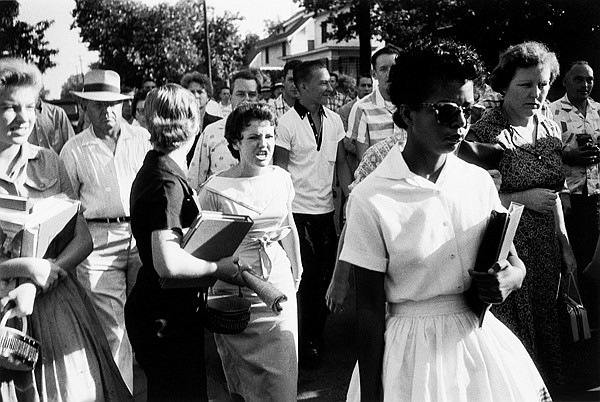55 And Counting
‘Little Rock Nine’ remembered in iconic images
Elizabeth Eckford, one of the students who attempted to integrate Little Rock’s Central High School, was captured in this iconic photo by Will Counts. His work is on display this month at UAFS.
Friday, January 11, 2013
The images became iconic the moment they appeared in the Arkansas Democrat on a September day 55 years ago: A black 15-year-old named Elizabeth Eckford is tormented by a jeering mob, one of them screaming into the lens of Will Counts’ camera. Alone at a bus stop, the same teenager is engulfed by protesters, a “stop” sign ironically framed by the crowd. Surrounded by newsmen, an Arkansas National Guard officer talks with students barred from Little Rock’s Central High School on the first day of integration.
A traveling exhibition from the Arkansas Arts Center in Little Rock, on display at the Smith-Pendergraft Campus Center at the University of Arkansas, Fort Smith, “gives a better sense of the atmosphere, the tension that surrounded the events of 1957,” says Keith Melton, assistant registrar at the Arkansas Arts Center. “It allows further insight into the whole story.
I think this exhibit continues to be popular because it documents such a complex time in our state’s history, and images like this take it out of the history book and make it relatable.
“A hidden gem of this exhibit is it gives the viewer a real sense of how a news photographer approaches an event such as this,” Melton adds.
That photographer, Ira Wilmer Counts Jr., born in 1931 to Central Arkansas sharecroppers, attended Central High School himself when it was still known as Little Rock High School. He studied education at Arkansas State Teachers College - nowthe University of Central Arkansas- and worked as a school photographer and stringer for the Arkansas Gazette and the Arkansas Democrat, according to the Encyclopedia of Arkansas History & Culture. After earning a master’s degree at Indiana University, he returned to the Arkansas Democrat in June of 1957, just in time for the crisis at Central High.
“From the time Elizabeth first approached the National Guard, you knew this was a major confrontation between the governor and the federalgovernment,” The New York Times quoted Counts in an October 2001 obituary. “She became a symbol for the Little Rock crisis.
“I felt empathy, but this is a job,” he added. “That’s what you’re trained to do. You just hope you have film.”
One of the things viewers of Counts’ photos might be unpleasantly surprised to learn is that the integration of the “Little Rock Nine” was the beginning, not the end, of the fight over desegregation in the Arkansas capital. In a timeline accompanying the collection, which Counts donated to theArkansas Arts Center in 1997, exhibitgoers will discover that although the black students successfully completed the 1957-58 school year at Central High School - with Ernest Green graduating on May 27, 1958 - the fight continued off and on until the fall of 1972.
Viewers might be pleasantly surprised, however, to see the success of the Little Rock Nine in adulthood. Eckford, for example, made a career in the U.S. Army. And Green, the first to graduate, was assistant secretary of housing and urban affairs under President Jimmy Carter.
Whats Up, Pages 13 on 01/11/2013
